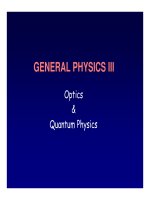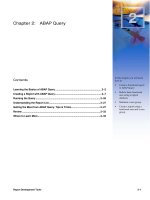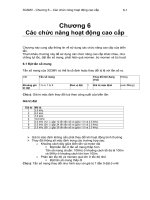- Trang chủ >>
- Khoa Học Tự Nhiên >>
- Vật lý
Tài liệu Chapter XII Magnetic materials pdf
Bạn đang xem bản rút gọn của tài liệu. Xem và tải ngay bản đầy đủ của tài liệu tại đây (255.09 KB, 19 trang )
4/1/2008 1
GENERAL PHYSICS II
Electromagnetism
&
Thermal Physics
4/1/2008 2
Chapter XII
Magnetic materials
§1. Atomic magnetic moment - Bohr magneton
§2. Magnetization, paramagnetism and diamagnetism
§3. Ferromagnetism
4/1/2008 3
Investigation of the magnetic properties of materials is very important,
because magnetic phenomena have various scientific and technical
applications.
The macroscopic properties of matter are a manifestation of the
microscopic properties of the atoms of which it is composed.
The magnetic properties of materials may be very different for types of
material, depending on their nature and structure.
4/1/2008 4
§1. Atomic magnetic moment – Bohr magneton:
In order to understand the magnetic properties of matter we must
know the magnetic properties of atoms.
1.1 The magnetic moment of an orbiting charge :
Moving electrons, protons, neutrons create currents they have
magnetic dipole moments.
The motions of these particles can be decomposed into orbital
motion and spinning motion
The current created by the orbiting particle is
4/1/2008 5
• Its magnetic moment is
The vector form:
where L
0
is angular momentum of
the orbital motion.
It is known that for an electron in the ground (non-excited) state of
the hydrogen atom the angular momentum equals to 1.05 x 10
-34
J.s
(we will learn later in quantum physics), so we have for the orbital
magnetic moment of electron:
This quantity is the fundamental unit of magnetic moment, it is called
Bohr magneton
= 9.22 x 10
-24
A.m
2
.
4/1/2008 6
2.3 The magnetic moment of a spinning charge:
Consider a spinning charge:
A ring dq of the spinning charge creates the current:
The corresponding magnetic moment of the ring is
Summing over all the rings:
Assume that the charge is distributed in the same way as the mass,
we can write
I= L
The spin magnetic moment vector
4/1/2008 7
The particular case of an electron:
An electron is known to have spin angular momentum of
0.527 x 10
-34
J.s. So, its spin magnetic moment is
However, experiments give the result of twice bigger. Why?
The problem lies with the assumption about the charge distribution
that we have used.
To correct this mistake one introduces the factor g called
“gyromagnetic ratio“, and writes
For electrons g = 2.









